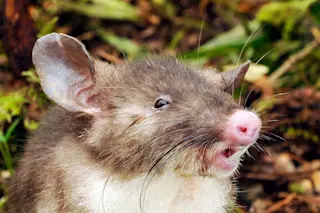Mett the hog-nosed rat. (Credit: Kevin C. Rowe, Senior Curator of Mammals, Museum Victoria) A recently discovered rat has a face only a mother could love. An international team of researchers studying animals in the isolated, mountainous island of Sulawesi, Indonesia, trapped a shrewlike critter with a distinctive pink snout on Mount Dako in 2013. As it turns out, the critter was previously unknown to science, and the team finally introduced the rest of the world to the newly discovered hog-nosed rat, Hyorhinomys stuempkei.One of a Kind As scientists worked to describe the rat, they quickly discovered it was significantly different from other rat and shrew species. In fact, genetically speaking, the hog-nosed rat was so unique that scientists described it as an entirely new genus. And on the surface, H. stuempkei stands out from other rodents. Apart from its distinctive piglike nose, the hog-nosed rat also sports longer front ...
Newly Discovered Hog-Nosed Rat is an Indonesian Oddity
Meet the hog-nosed rat, a newly discovered species with a distinctive pink snout, found in Sulawesi, Indonesia. Explore its uniqueness!
More on Discover
Stay Curious
SubscribeTo The Magazine
Save up to 40% off the cover price when you subscribe to Discover magazine.
Subscribe













